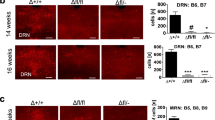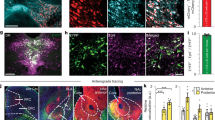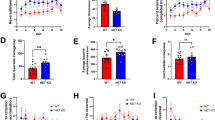Abstract
Although the serotonin (5-hydroxytryptamine, 5-HT) neurotransmitter system has been implicated in modulating executive control processes such as attention, response inhibition, and behavioral flexibility, the contributions of particular serotonin receptors remain unclear. Here, using operant-based behavioral paradigms, we demonstrate that mice with genetically ablated 5-HT2C receptors (2CKO mice) display deficits in executive functions. 2CKO mice were impaired in the acquisition of a visuospatial attention task as assessed in the 5-choice serial reaction time task (5-CSRTT). In this task, 2CKO mice exhibited marked impairment of attentional processes, with normal response inhibition. We assessed dynamic changes in neurotransmitter levels within the nucleus accumbens (NAc) by in vivo microdialysis in task-performing animals. Extracellular dopamine concentrations were elevated in the NAc of 2CKO mice during task performance, indicating that 5-HT2C receptors impact dopamine homeostasis during a visuospatial attention task. These findings raise the possibility that disinhibition of mesolimbic dopamine pathways contributes to impaired attention and perturbed task performance in 2CKO mice. Additionally, in a spatial reversal learning task, 2CKO mice failed to improve their performance over a series of reversals, indicating that intact 5-HT2C receptor signaling is required to accurately respond to repeated changes in reward contingencies. In contrast to the 2CKO phenotype in the 5-CSRTT, wild-type mice treated with the 5-HT2C receptor antagonist SB242084 exhibited diminished response inhibition, suggesting differing effects of acute pharmacological blockade and constitutive loss of 5-HT2C receptor activity. Altogether, these findings provide insights into the serotonergic regulation of executive control processes and suggest that impaired 5-HT2C receptor signaling during development may predispose to executive function disorders.
Similar content being viewed by others
Log in or create a free account to read this content
Gain free access to this article, as well as selected content from this journal and more on nature.com
or
References
Abdallah L, Bonasera SJ, Hopf FW, O’Dell L, Giorgetti M, Jongsma M et al (2009). Impact of serotonin 2C receptor null mutation on physiology and behavior associated with nigrostriatal dopamine pathway function. J Neurosci 29: 8156–8165.
Agnoli L, Carli M (2012). Dorsal-striatal 5-HT(2)A and 5-HT(2)C receptors control impulsivity and perseverative responding in the 5-choice serial reaction time task. Psychopharmacology (Berl) 219: 633–645.
Alex KD, Pehek EA (2007). Pharmacologic mechanisms of serotonergic regulation of dopamine neurotransmission. Pharmacol Ther 113: 296–320.
Angoa-Perez M, Kane MJ, Briggs DI, Sykes CE, Shah MM, Francescutti DM et al (2012). Genetic depletion of brain 5HT reveals a common molecular pathway mediating compulsivity and impulsivity. J Neurochem 121: 974–984.
Bari A, Dalley JW, Robbins TW (2008). The application of the 5-choice serial reaction time task for the assessment of visual attentional processes and impulse control in rats. Nat Protoc 3: 759–767.
Bayer LE, Brown A, Mactutus CF, Booze RM, Strupp BJ (2000). Prenatal cocaine exposure increases sensitivity to the attentional effects of the dopamine D1 agonist SKF81297. J Neurosci 20: 8902–8908.
Bobb AJ, Addington AM, Sidransky E, Gornick MC, Lerch JP, Greenstein DK et al (2005). Support for association between ADHD and two candidate genes: NET1 and DRD1. Am J Med Genet Part B 134B: 67–72.
Bonasera SJ (2011). Insights into 5-HT2C Receptor Function Gained from Transgenic Mouse Models. In: Di Giovanni G et al, (eds). The Receptors - 5-HT2C Receptors in the Pathophysiology of CNS Disease. Humana Press: New York. vol 22, pp 51–73.
Boulougouris V, Glennon JC, Robbins TW (2008). Dissociable effects of selective 5-HT2A and 5-HT2C receptor antagonists on serial spatial reversal learning in rats. Neuropsychopharmacology 33: 2007–2019.
Boulougouris V, Robbins TW (2010). Enhancement of spatial reversal learning by 5-HT2C receptor antagonism is neuroanatomically specific. J Neurosci 30: 930–938.
Brookes K, Xu X, Chen W, Zhou K, Neale B, Lowe N et al (2006). The analysis of 51 genes in DSM-IV combined type attention deficit hyperactivity disorder: association signals in DRD4, DAT1 and 16 other genes. Mol Psychiatry 11: 934–953.
Chamberlain SR, Muller U, Blackwell AD, Clark L, Robbins TW, Sahakian BJ (2006). Neurochemical modulation of response inhibition and probabilistic learning in humans. Science 311: 861–863.
Clarke HF, Dalley JW, Crofts HS, Robbins TW, Roberts AC (2004). Cognitive inflexibility after prefrontal serotonin depletion. Science 304: 878–880.
Clatworthy PL, Lewis SJ, Brichard L, Hong YT, Izquierdo D, Clark L et al (2009). Dopamine release in dissociable striatal subregions predicts the different effects of oral methylphenidate on reversal learning and spatial working memory. J Neurosci 29: 4690–4696.
Cole BJ, Robbins TW (1987). Amphetamine impairs the discriminative performance of rats with dorsal noradrenergic bundle lesions on a 5-choice serial reaction time task: new evidence for central dopaminergic-noradrenergic interactions. Psychopharmacology (Berl) 91: 458–466.
Cole BJ, Robbins TW (1989). Effects of 6-hydroxydopamine lesions of the nucleus accumbens septi on performance of a 5-choice serial reaction time task in rats: implications for theories of selective attention and arousal. Behav Brain Res 33: 165–179.
Cools R, Roberts AC, Robbins TW (2008). Serotoninergic regulation of emotional and behavioural control processes. Trends Cogn Sci 12: 31–40.
Cortese S, Vincenzi B (2012). Obesity and ADHD: clinical and neurobiological implications. Curr Topics Behav Neurosci 9: 199–218.
Dalley JW, Theobald DE, Berry D, Milstein JA, Laane K, Everitt BJ et al (2005). Cognitive sequelae of intravenous amphetamine self-administration in rats: evidence for selective effects on attentional performance. Neuropsychopharmacology 30: 525–537.
De Deurwaerdere P, Navailles S, Berg KA, Clarke WP, Spampinato U (2004). Constitutive activity of the serotonin2C receptor inhibits in vivo dopamine release in the rat striatum and nucleus accumbens. J Neurosci 24: 3235–3241.
Dempsey A, Dyehouse J, Schafer J (2011). The relationship between executive function, AD/HD, overeating, and obesity. Western J Nurs Res 33: 609–629.
Di Giovanni G, Di Matteo V, Pierucci M, Esposito E (2008). Serotonin-dopamine interaction: electrophysiological evidence. Prog Brain Res 172: 45–71.
Doe CM, Relkovic D, Garfield AS, Dalley JW, Theobald DE, Humby T et al (2009). Loss of the imprinted snoRNA mbii-52 leads to increased 5htr2c pre-RNA editing and altered 5HT2CR-mediated behaviour. Hum Mol Genet 18: 2140–2148.
Doyle AE (2006). Executive functions in attention-deficit/hyperactivity disorder. J Clin Psychiatry 67 (Suppl 8): 21–26.
Drago A, Serretti A (2009). Focus on HTR2C: A possible suggestion for genetic studies of complex disorders. Am J Med Genet Part B 150B: 601–637.
Enge S, Fleischhauer M, Lesch KP, Strobel A (2011). On the role of serotonin and effort in voluntary attention: evidence of genetic variation in N1 modulation. Behav Brain Res 216: 122–128.
Fineberg NA, Potenza MN, Chamberlain SR, Berlin HA, Menzies L, Bechara A et al (2010). Probing compulsive and impulsive behaviors, from animal models to endophenotypes: a narrative review. Neuropsychopharmacology 35: 591–604.
Fletcher PJ, Tampakeras M, Sinyard J, Higgins GA (2007a). Opposing effects of 5-HT(2A) and 5-HT(2C) receptor antagonists in the rat and mouse on premature responding in the five-choice serial reaction time test. Psychopharmacology (Berl) 195: 223–234.
Fletcher PJ, Tenn CC, Sinyard J, Rizos Z, Kapur S (2007b). A sensitizing regimen of amphetamine impairs visual attention in the 5-choice serial reaction time test: reversal by a D1 receptor agonist injected into the medial prefrontal cortex. Neuropsychopharmacology 32: 1122–1132.
Floresco SB, Jentsch JD (2010). Pharmacological enhancement of memory and executive functioning in laboratory animals. Neuropsychopharmacology 36: 227–250.
Giorgetti M, Tecott LH (2004). Contributions of 5-HT(2C) receptors to multiple actions of central serotonin systems. Eur J Pharmacol 488: 1–9.
Gobert A, Rivet JM, Lejeune F, Newman-Tancredi A, Adhumeau-Auclair A, Nicolas JP et al (2000). Serotonin(2C) receptors tonically suppress the activity of mesocortical dopaminergic and adrenergic, but not serotonergic, pathways: a combined dialysis and electrophysiological analysis in the rat. Synapse 36: 205–221.
Granon S, Passetti F, Thomas KL, Dalley JW, Everitt BJ, Robbins TW (2000). Enhanced and impaired attentional performance after infusion of D1 dopaminergic receptor agents into rat prefrontal cortex. J Neurosci 20: 1208–1215.
Harrison AA, Everitt BJ, Robbins TW (1997). Central 5-HT depletion enhances impulsive responding without affecting the accuracy of attentional performance: interactions with dopaminergic mechanisms. Psychopharmacology (Berl) 133: 329–342.
Humby T, Wilkinson L, Dawson G (2005). Assaying aspects of attention and impulse control in mice using the 5-choice serial reaction time task. Curr Protoc Neurosci Chapter 8:Unit 8: 5H.
Hutson PH, Barton CL, Jay M, Blurton P, Burkamp F, Clarkson R et al (2000). Activation of mesolimbic dopamine function by phencyclidine is enhanced by 5-HT(2C/2B) receptor antagonists: neurochemical and behavioural studies. Neuropharmacology 39: 2318–2328.
Itami S, Uno H (2002). Orbitofrontal cortex dysfunction in attention-deficit hyperactivity disorder revealed by reversal and extinction tasks. Neuroreport 13: 2453–2457.
Koskinen T, Ruotsalainen S, Puumala T, Lappalainen R, Koivisto E, Mannisto PT et al (2000). Activation of 5-HT2A receptors impairs response control of rats in a five-choice serial reaction time task. Neuropharmacology 39: 471–481.
Li J, Wang Y, Zhou R, Zhang H, Yang L, Wang B et al (2006). Association between polymorphisms in serotonin 2C receptor gene and attention-deficit/hyperactivity disorder in Han Chinese subjects. Neurosci Lett 407: 107–111.
Lopez-Gimenez JF, Tecott LH, Palacios JM, Mengod G, Vilaro MT (2002). Serotonin 5-HT (2C) receptor knockout mice: autoradiographic analysis of multiple serotonin receptors. J Neurosci Res 67: 69–85.
Mickey BJ, Sanford BJ, Love TM, Shen PH, Hodgkinson CA, Stohler CS et al (2012). Striatal dopamine release and genetic variation of the serotonin 2C receptor in humans. J Neurosci 32: 9344–9350.
Navailles S, De Deurwaerdère P (2011). The Constitutive Activity of 5-HT2C Receptors as an Additional Modality of Interaction of the Serotonergic System. In: Di Giovanni G, et al (eds). The Receptors - 5-HT2C Receptors in the Pathophysiology of CNS Disease. Humana Press: New York, vol. 22 pp 187–213.
Nilsson SR, Ripley TL, Somerville EM, Clifton PG (2012). Reduced activity at the 5-HT(2C) receptor enhances reversal learning by decreasing the influence of previously non-rewarded associations. Psychopharmacology (Berl) 224: 241–254.
Nonogaki K, Abdallah L, Goulding EH, Bonasera SJ, Tecott LH (2003). Hyperactivity and reduced energy cost of physical activity in serotonin 5-HT(2C) receptor mutant mice. Diabetes 52: 315–320.
Oades RD (2008). Dopamine-serotonin interactions in attention-deficit hyperactivity disorder (ADHD). Prog Brain Res 172: 543–565.
Passetti F, Dalley JW, Robbins TW (2003). Double dissociation of serotonergic and dopaminergic mechanisms on attentional performance using a rodent five-choice reaction time task. Psychopharmacology (Berl) 165: 136–145.
Pezze MA, Dalley JW, Robbins TW (2007). Differential roles of dopamine D1 and D2 receptors in the nucleus accumbens in attentional performance on the five-choice serial reaction time task. Neuropsychopharmacology 32: 273–283.
Relkovic D, Doe CM, Humby T, Johnstone KA, Resnick JL, Holland AJ et al (2010). Behavioural and cognitive abnormalities in an imprinting centre deletion mouse model for Prader-Willi syndrome. Eur J Neurosci 31: 156–164.
Robbins TW, Arnsten AF (2009). The neuropsychopharmacology of fronto-executive function: monoaminergic modulation. Annu Rev Neurosci 32: 267–287.
Robinson ES, Dalley JW, Theobald DE, Glennon JC, Pezze MA, Murphy ER et al (2008). Opposing roles for 5-HT2A and 5-HT2C receptors in the nucleus accumbens on inhibitory response control in the 5-choice serial reaction time task. Neuropsychopharmacology 33: 2398–2406.
Rocha BA, Goulding EH, O'Dell LE, Mead AN, Coufal NG, Parsons LH et al (2002). Enhanced locomotor, reinforcing, and neurochemical effects of cocaine in serotonin 5-hydroxytryptamine 2C receptor mutant mice. J Neurosci 22: 10039–10045.
Simpson EH, Kellendonk C, Kandel E (2010). A possible role for the striatum in the pathogenesis of the cognitive symptoms of schizophrenia. Neuron 65: 585–596.
Spinelli S, Pennanen L, Dettling AC, Feldon J, Higgins GA, Pryce CR (2004). Performance of the marmoset monkey on computerized tasks of attention and working memory. Brain Res Cogn Brain Res 19: 123–137.
Talpos JC, Wilkinson LS, Robbins TW (2006). A comparison of multiple 5-HT receptors in two tasks measuring impulsivity. J Psychopharmacol 20: 47–58.
Tecott LH, Sun LM, Akana SF, Strack AM, Lowenstein DH, Dallman MF et al (1995). Eating disorder and epilepsy in mice lacking 5-HT2c serotonin receptors. Nature 374: 542–546.
Terry AV, Buccafusco JJ, Schade RF, Vandenhuerk L, Callahan PM, Beck WD et al (2012). The nicotine metabolite, cotinine, attenuates glutamate (NMDA) antagonist-related effects on the performance of the five choice serial reaction time task (5C-SRTT) in rats. Biochem Pharmacol 83: 941–951.
Tsaltas E, Boulougouris V (2011). The Role of Serotonin in Attentional Processes and Executive Functioning: Focus on 5-HT2C Receptors. In: Di Giovanni G, (eds). The Receptors - 5-HT2C Receptors in the Pathophysiology of CNS Disorders. Humana Press: New York, vol. 22 pp 445–459.
van der Meulen JA, Bilbija L, Joosten RN, de Bruin JP, Feenstra MG (2003). The NMDA-receptor antagonist MK-801 selectively disrupts reversal learning in rats. Neuroreport 14: 2225–2228.
Werry TD, Loiacono R, Sexton PM, Christopoulos A (2008). RNA editing of the serotonin 5HT2C receptor and its effects on cell signalling, pharmacology and brain function. Pharmacol Ther 119: 7–23.
Winstanley CA, Theobald DE, Dalley JW, Glennon JC, Robbins TW (2004). 5-HT2A and 5-HT2C receptor antagonists have opposing effects on a measure of impulsivity: interactions with global 5-HT depletion. Psychopharmacology (Berl) 176: 376–385.
Xu X, Brookes K, Sun B, Ilott N, Asherson P (2009). Investigation of the serotonin 2C receptor gene in attention deficit hyperactivity disorder in UK samples. BMC Res Notes 2: 71.
Yan TC, Dudley JA, Weir RK, Grabowska EM, Pena-Oliver Y, Ripley TL et al (2011). Performance deficits of NK1 receptor knockout mice in the 5-choice serial reaction-time task: effects of d-amphetamine, stress and time of day. PLoS One 6: e17586.
Zahrt J, Taylor JR, Mathew RG, Arnsten AF (1997). Supranormal stimulation of D1 dopamine receptors in the rodent prefrontal cortex impairs spatial working memory performance. J Neurosci 17: 8528–8535.
Acknowledgements
We thank Elaine Carlson, Ethelyn Layco, and Otis D Morgan III for technical assistance involved with these experiments. This work was funded by the SNSF-Swiss National Science Foundation—PBZH33-114661 (Pennanen), and Postdoctoral Research Fellowship from the American Foundation for Suicide Prevention (AFSP) (Pennanen).
Author information
Authors and Affiliations
Corresponding author
Ethics declarations
Competing interests
The authors declare no conflict of interest.
Additional information
Supplementary Information accompanies the paper on the Neuropsychopharmacology website
Rights and permissions
About this article
Cite this article
Pennanen, L., van der Hart, M., Yu, L. et al. Impact of Serotonin (5-HT)2C Receptors On Executive Control Processes. Neuropsychopharmacol 38, 957–967 (2013). https://doi.org/10.1038/npp.2012.258
Received:
Revised:
Accepted:
Published:
Issue date:
DOI: https://doi.org/10.1038/npp.2012.258
Keywords
This article is cited by
-
Association of Serotonin Receptors with Attention Deficit Hyperactivity Disorder: A Systematic Review and Meta-analysis
Current Medical Science (2018)
-
Dissociable Deficits of Executive Function Caused by Gestational Adversity are Linked to Specific Transcriptional Changes in the Prefrontal Cortex
Neuropsychopharmacology (2015)
-
The role of 5-HT2C receptors in touchscreen visual reversal learning in the rat: a cross-site study
Psychopharmacology (2015)



